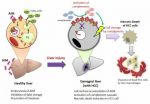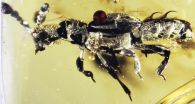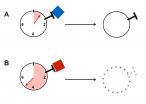(Press-News.org) This release is available in Japanese.
A University of Tokyo research group has discovered that AIM (Apoptosis Inhibitor of Macrophage), a protein that plays a preventive role in obesity progression, can also prevent tumor development in mice liver cells. This discovery may lead to a therapy for hepatocellular carcinoma (HCC), the most common type of liver cancer and the third most common cause of cancer deaths.
Professor Toru Miyazaki's group at the Laboratory of Molecular Biomedicine from Pathogenesis, in the Faculty of Medicine has shown that AIM (also known as CD5L) accumulates on the cell membrane of HCC cells, where it triggers the complement cascade, a highly efficient process of eliminating cancerized cells. Experiments showed that mice unable to produce AIM fed on a high-fat diet for a year developed multiple liver tumors. Additionally, when the same type of mice on the same diet for 45 weeks, at which point they would have already developed HCC, showed no signs of HCC after treatment with AIM, indicating that cancerous cells were being destroyed.
The group had previously found AIM, and identified its supportive role for the immune system and a protective role in obesity progression of fat cells. Now they have found that AIM is involved in eliminating cancerized cells. The group revealed that AIM accumulates on the surface of mice HCC cells, but not on normal cells and showed that AIM interferes with proteins that normally suppress the complement cascade, triggering a process that leads to necrosis and elimination of the cancerous cells.
HCC can be caused by several factors including a high-fat diet, and this form of liver cancer is increasing due to rising obesity. "Because of its resistance to chemotherapy, HCC is now the third most common cause of cancer-related deaths, and therefore, it is certainly desirable to identify the preventive machinery against HCC. The most exciting finding for us is that AIM behaves in two different ways in preventing liver diseases. It enters into normal hepatocytes to keep them skinny, which prevents the buildup of fat inside cells seen in steatosis, whereas it accumulates on the surface of HCC cells to kill them," says Professor Miyazaki. Given that AIM also gathers on the surface of human HCC, it may be possible to develop AIM as a therapy for human HCC. Professor Miyazaki continues, "It is surprising that we do have an excellent system to eliminate undesired cancer cells, and that this system may certainly be therapeutically applicable not only to HCC, but also more broadly to other types of cancer."
INFORMATION:
Journal article
Natsumi Maehara, Satoko Arai, Mayumi Mori, Yoshihiro Iwamura, Jun Kurokawa, Toshihiro Kai, Shunsuke Kusunoki, Kaori Taniguchi, Kazutaka Ikeda, Osamu Ohara, Ken-ichi Yamamura, and Toru Miyazaki, "Circulating AIM Prevents Hepatocellular Carcinoma through Complement Activation," Cell Reports 9, 1-14 (forthcoming: 9 October 2014).
http://dx.doi.org/10.1016/j.celrep.2014.08.058
Links
Laboratory of Molecular Biomedicine from Pathogenesis,
Center for Disease Biology and Integrative Medicine
Faculty of Medicine
The University of Tokyo
Contact information
Professor Toru Miyazaki
Laboratory of Molecular Biomedicine from Pathogenesis, Center for Disease Biology and Integrative Medicine, Faculty of Medicine, The University of Tokyo
Email: tm@m.u-tokyo.ac.jp
Secretary: Inoue Shiho, Inoue Yukari
Email: miya@m.u-tokyo.ac.jp
Tel: +81-3-5841-1436
Fax: +81-3-5841-1438
Graduate School of Medicine press officer & contact information
Ryosuke Nobukawa
General Affairs Office
Graduate School of Medicine, The University of Tokyo
Email: ishomu@m.u-tokyo.ac.jp
Tel: +81-3-5841-3304
Fax: +81-3-5841-8585
Stopping liver cancer in its tracks
2014-10-02
ELSE PRESS RELEASES FROM THIS DATE:
Ancient protein-making enzyme moonlights as DNA protector
2014-10-02
LA JOLLA, CA—October 2, 2014—Scientists at The Scripps Research Institute (TSRI) have found that an enzyme best known for its fundamental role in building proteins has a second major function: to protect DNA during times of cellular stress.
The finding is remarkable on a basic science level but also points the way to possible therapeutic applications. Strategies that enhance the DNA-protection function of the enzyme, TyrRS, could help protect people from radiation injuries as well as from hereditary defects in DNA repair systems.
"We overexpressed TyrRS in zebrafish ...
52-million-year-old amber preserves 'ant-loving' beetle
2014-10-02
Scientists have uncovered the fossil of a 52-million-year old beetle that likely was able to live alongside ants—preying on their eggs and usurping resources—within the comfort of their nest. The fossil, encased in a piece of amber from India, is the oldest-known example of this kind of social parasitism, known as "myrmecophily." Published today in the journal Current Biology, the research also shows that the diversification of these stealth beetles, which infiltrate ant nests around the world today, correlates with the ecological rise of modern ants.
"Although ants ...
Counting the seconds for immunological tolerance
2014-10-02
Our immune system must distinguish between self and foreign and in order to fight infections without damaging the body's own cells at the same time. The immune system is loyal to cells in the body, but how this works is not fully understood. Researchers in the Departments of Biomedicine and Nephrology at the University Hospital and the University of Basel have discovered that the immune system uses a molecular biological clock to target intolerant T cells during their maturation process. These recent findings have been reported in the scientific journal Cell.
A functioning ...
DNA 'bias' may keep some diseases in circulation, Penn biologists show
2014-10-02
It's an early lesson in genetics: we get half our DNA from Mom, half from Dad.
But that straightforward explanation does not account for a process that sometimes occurs when cells divide. Called gene conversion, the copy of a gene from Mom can replace the one from Dad, or vice versa, making the two copies identical.
In a new study published in the American Journal of Human Genetics, University of Pennsylvania researchers Joseph Lachance and Sarah A. Tishkoff investigated this process in the context of the evolution of human populations. They found that a bias toward ...
Study indicates possible new way to treat endometrial, colon cancers
2014-10-02
Scientists love acronyms.
In the quest to solve cancer's mysteries, they come in handy when describing tongue-twisting processes and pathways that somehow allow tumors to form and thrive. Two examples are ERK (extracellular-signal-related kinase) and JNK (c-June N-Terminal Kinase), enzymes that may offer unexpected solutions for treating some endometrial and colon cancers.
A study led by Gordon Mills, M.D., Ph.D., professor and chair of Systems Biology at The University of Texas MD Anderson Cancer Center with Lydia Cheung, Ph.D. as the first author, points to cellular ...
Study gauges humor by age
2014-10-02
Television sitcoms in which characters make jokes at someone else's expense are no laughing matter for older adults, according to a University of Akron researcher.
Jennifer Tehan Stanley, an assistant professor of psychology, studied how young, middle-aged and older adults reacted to so-called "aggressive humor"—the kind that is a staple on shows like The Office.
By showing clips from The Office and other sitcoms (Golden Girls, Mr. Bean, Curb Your Enthusiasm) to adults of varying ages, she and colleagues at two other universities found that young and middle-aged adults ...
Strong working memory puts brakes on problematic drug use
2014-10-02
AUDIO:
Atika Khurana, assistant professor in the University of Oregon's Department of Counseling Psychology and Human Services, provides a short summary and the implications of a study that looked at the...
Click here for more information.
EUGENE, Ore. -- Oct. 2, 2014 -- Adolescents with strong working memory are better equipped to escape early drug experimentation without progressing into substance abuse issues, says a University of Oregon researcher.
Most important in the picture ...
Sense of invalidation uniquely risky for troubled teens
2014-10-02
PROVIDENCE, R.I. [Brown University] — Among the negative feelings that can plague a teen's psyche is a perception of "invalidation," or a lack of acceptance. A new study by Brown University and Butler Hospital researchers suggests that independent of other known risk factors, measuring teens' sense of invalidation by family members or peers can help predict whether they will try to harm themselves or even attempt suicide.
In some cases, as with peers, that sense of invalidation could come from being bullied, but it could also be more subtle. In the case of family, for ...
Socioeconomic factors, fashion trends linked to increase in melanoma
2014-10-02
NEW YORK, NY - A century's worth of cultural and historical forces have contributed to the rise in the incidence of melanoma, including changes in fashion and clothing design, according to an intriguing, retrospective research study conducted by investigators in the Ronald O. Perelman Department of Dermatology at NYU Langone Medical Center.
Their findings are the subject of a report, "More Skin, More Sun, More Tan, More Melanoma," in the October 6, 2014 issue of the American Journal of Public Health.
The authors surmised that early diagnosis and improved reporting ...
Herbivores play important role in protecting habitats from invasive species
2014-10-02
Champaign Ill. Herbivores (species that eat plants; e.g. caterpillars) consume more non-native (introduced from other places) oak leaf material in areas with diverse native plant communities than in less diverse communities. Why diverse plant communities tend to resist invasion by non-native plants, remains uncertain. Researchers from the Illinois Natural History Survey and the Morton Arboretum have been examining the potential role of herbivores on the invasion of non-native plant species in diverse plant communities.
The researchers examined herbivore damage on leaves ...





